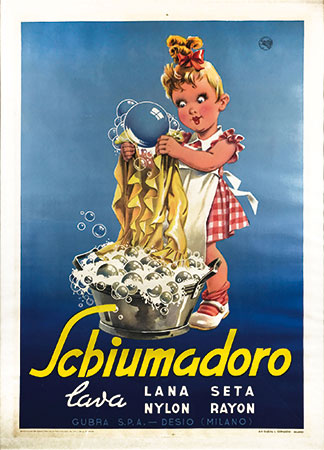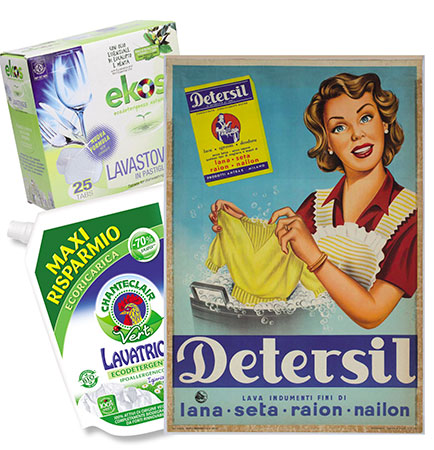Domestic detergency: products and packaging
Market trends and types of packaging related to detergents, laundry soaps, washing adjuvants, environmental disinfectants and disinfestants, waxes, car care products, environmental deodorants ...
 Based on the latest observatory carried out by Assocasa - the association that brings together the sector’s producers within Federchimica - it appears that, in 2018, the entire sector registered growth in terms of value of 1.4% compared to to 2017; sustainability, innovation and well-being seem to have been the keywords for success.
Based on the latest observatory carried out by Assocasa - the association that brings together the sector’s producers within Federchimica - it appears that, in 2018, the entire sector registered growth in terms of value of 1.4% compared to to 2017; sustainability, innovation and well-being seem to have been the keywords for success.
From the analysis presented by the association it emerges that the only sector in distress is that of detergents (-0.4% in value), where the greatest losses are found in detergents for dishwashers (tabs and powders) and for tableware (-1,6%). In the same area, dishwasher gel detergents gave the sector a lift and helped contain the losses, preferred in that it is easier to control the dosage. As for laundry detergents, single doses are on the up and the use of washing powder is dropping. These shifts, as we will see later, also determine consequent changes in the packaging mix.
The market
According to Istat surveys, global production in terms of quantities in the detergent area in 2018 are up by 2%. Foreign trade closed 2018 with + 4% for imports and + 8% for exports. Apparent consumption registered a drop of 1.7%, settling at around 1,760 t/000.
From the study of the data, the difference between the growth index in terms of value and that expressed in quantitative terms lies in the tendency of consumers to move towards products on offer or subject to promotions (“I spend less, but buy more”).
On the other hand, it should also be considered that a growing number of concentrated products are being launched on the market, thanks to which a greater number of washes can be made while using a smaller amount of product. This leads to more limited growth trends in quantitative terms than in the past.
T should also be considered that, year after year, consumers increasingly appreciate detergents in tablet rather than liquid form, especially for doing the laundry: also in this case the weight of the purchased product is reduced.
Precisely for these reasons, the detergent industry is implementing a series of actions to be able, on the one hand, to meet the needs and demands of families, and on the other to offer innovative and high-performance products.
What influences production choices - and, consequently, packaging - are consumers’ attitudes, certainly attentive towards saving but also towards environmental protection.
In 2018, the excellent performance of the pesticides sector was again confirmed, registering a value of +14.6%, influenced by the prolongation of high temperatures even into the first months of autumn.

Distribution channels
As for the sales channels, again according to the analysis by Assocasa, also in 2019 the Drug Specialists continue to grow, becoming in the second distribution channel in Italy after supermarkets; thanks to the excellent quantitative and qualitative assortment, flanked by good saving opportunities, this type of store in 2018 put in a +8.1%. Discount stores improved their sales compared to 2017, registering + 2.8%. Self service facilities are down (-3.4%), while hyper and super stores are substantially stable.
The types of packaging
In the detergent sector, plastic packaging continues to dominate, be it rigid or flexible; the only shifts in market shares registered continue to be those between the different types of plastic or formats.
The choice of packaging material, as in the entire chemical sector, is largely functional to the chemical and physical characteristics of the product to be packaged, but it also depends on communication requirements which, increasingly, are decisive in setting apart the various commercial brands and product innovations.
Analysing the figures of the Italian Packaging Institute databank, the packaging mix highlights the following.
In 2018, plastic packaging covered 93.5% of the packaging of products for cleaning and maintenance of environments, a constant percentage for some years now. This percentage includes packaging made of biodegradable plastic, which is constantly growing.
Specifically we find:
- plastic bottles, which in 2016 stood at 66.5%, up slightly compared to 2017, due to the orientation of consumers towards products packaged exclusively with this packaging (see gel dishwashers detergents );
- containers made with flexible laminated converter material, which grow year after year and, in 2018 accounted for 23.5% of the total packaging in the sector;
- refills for detergent bottles made with biodegradable plastic (an addition to the plastic packaging family) and are constantly growing, reaching 1.5% of the total packaging mix in 2018.
This latter type of packaging, in particular, is intended for concentrated products which, mixed with hot water inside a bottle, dissolve, releasing whatever is necessary to reconstitute the original detergent . Still in the “plastic packaging” area we find the wrappers used for soap bars (1%) and tubes (1%).
To complete the packaging mix we find:
- cardboard boxes, used mainly for powdered products and for tabs for dishwashers which, in 2018, remained constant at 4%. If, on the one hand, this type of packaging has given way due to the drop in powder laundry detergents, on the other hand it regains positions for the growth of tabs, which are packaged in cardboard boxes;
- metal spray cans (now almost exclusively made of steel at the expense of aluminium) which settle at 1.5%;
- for two years rigid coupled containers have been at a 0.5% share;
- the remaining 0.5% is represented by vending machines for loose products, a phenomenon that in Italy has not taken root as in other countries and over the years is gradually fading.
Next to primary packaging we find secondary and transport packaging (corrugated cardboard boxes, shrink film and pallets).
 How much is the packaging of the domestic cleaning sector worth?
How much is the packaging of the domestic cleaning sector worth?
Based on an evaluation carried out through the the Italian Packaging Institute databank, it is estimated that the packaging sector for the domestic detergent area reaches a value of around 540 million euros, including closures made of plastic. Of these, around 61% is for the foreign market.
In the chemical products area, together with cosmetics and pharmaceuticals, it is the sector with the highest economic value in terms of packaging.
In terms of value, 89.6% of the packs for the detergent and home care sector can be attributed to plastic packaging (including closures), 7.3% to cellulose packaging, while the remaining 3.1% is accounted for by metal packaging.
Prospects
What are the prospects for 2019? Current trends tell us that the trends registered in 2018 will probably be confirmed, with a slight but steady growth in both volumes and value. For the packaging sector as well the prospects are those of a confirmation of the 2018 trends, with an orientation towards flexible converter packaging at the expense of rigid plastic packaging.
Barbara Iascone
Istituto Italiano Imballaggio



















